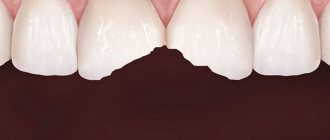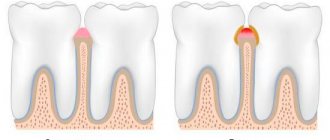Author of the article:
Soldatova Lyudmila Nikolaevna
Candidate of Medical Sciences, Professor of the Department of Clinical Dentistry of the St. Petersburg Medical and Social Institute, Chief Physician of the Alfa-Dent Dental Clinic, St. Petersburg
The taste of blood in the mouth is quite common. However, this symptom should never be ignored. Of course, the reasons for its appearance can be quite harmless, for example, a slight injury to the gums or eating food from clay dishes. However, an unpleasant taste can also indicate very dangerous pathologies. Let's figure out why a metallic taste may appear in the mouth and what to do to eliminate it as soon as possible, and most importantly, remove the reasons for its appearance.
Conventionally, all the causes of a pronounced metallic taste can be divided into three groups:
- Dental problems are usually associated with increased bleeding of the gums.
- Oral injuries.
- Internal pathologies.
Taking various medications often leads to a taste of blood in the mouth.
Oral injuries
If the mucous membrane is damaged, a little blood may enter the taste buds and, accordingly, a metallic taste appears in the mouth.
The causes of mucosal injury may be:
- tartar in the mouth;
- improper dental care, for example, using a brush that is too hard;
- incorrectly installed dentures;
- incorrectly installed braces.
Often the cause of the taste of blood in the mouth is a more significant injury, such as to the esophagus or throat. For example, a strong cough often leads to mucosal injuries. After an injury, a small amount of blood enters the mouth and causes an unpleasant taste.
Symptoms
The main symptom of nosebleeds is the discharge of blood from the nostrils or its flow into the mouth from the nasopharynx. However, depending on the blood loss, there are also accompanying signs:
- Nausea.
- Spitting blood.
- Pallor of the skin.
- Weakness.
- Noise in ears.
- Thirst.
- Cardiopalmus.
- Flashing of flies before the eyes.
- Dizziness.
Reference! With posterior bleeding, the patient may experience tarry stools, and if blood enters the stomach, vomiting interspersed with blood clots.
Internal pathologies
The most common diseases of internal organs that lead to the taste of blood in the mouth include:
- bronchitis;
- pneumonia (pneumonia);
- lung abscess;
- lungs' cancer;
- cystic fibrosis;
- tuberculosis;
- dysfunction of the heart;
- disruption of the gastrointestinal tract (GIT);
- diseases of the ENT organs.
Neurological diseases can also cause the taste of blood in the mouth. A signal travels through the nerve fibers of the brain to the taste buds; if its transmission is disrupted, an unusual taste may appear in the mouth.
However, neurological problems accompanied by a blood taste usually have other unpleasant manifestations. For example, they may be accompanied by headaches, hearing problems, hand tremors, trembling eyelids, and lumbago in certain areas of the face.
In very rare cases, the taste of blood in the mouth is caused by heavy metal poisoning. A similar problem often awaits workers in chemical laboratories and metal processing plants. Intoxication of the body is accompanied by other unpleasant symptoms - attacks of dry cough, nausea, aching limbs, swelling of the gums, and lack of appetite. Dysbacteriosis is also rarely the cause.
Causes
Why does such an alarming symptom appear?
Blood in the mouth after sleep has different sources, all possible ones are discussed below:
- The banal reason is mechanical damage to the gums, tongue and other parts of the oral cavity. Mucous and soft tissues can be damaged and lose integrity if you carelessly brush your teeth, use a toothbrush with hard bristles, carelessly use dental floss, fail to remove a piece of food stuck between your teeth, accidentally bite your tongue or cheek, or chew rough and hard food. After damage, a bleeding wound is noticeable, but it is sometimes difficult to detect.
- Periodontitis is inflammation of the gums. The mucous membranes and soft tissues become thinner and lose their integrity, the capillaries that penetrate them are damaged and burst. Patients experience increased bleeding that occurs during brushing teeth, chewing food, or in a calm state if the disease has become chronic and is in the acute stage.
- Blood found in the mouth after sleep may mean stomatitis, which can develop in both an adult and a child (the disease is more common in children). There are ulcers, white plaque, blisters, redness, and pain in the mouth. Stomatitis is caused by bacterial, fungal and viral infections: pathogens penetrate tissues through damaged areas.
- Gingivitis is an infectious lesion of the tongue, accompanied by a violation of tissue integrity.
- Throat diseases, such as tonsillitis. The acute form or chronic long-term course provokes damage to the mucous membranes and soft tissues of the tonsils. The capillaries burst, blood is released in moderate quantities, entering the saliva and turning it pinkish. With tonsillitis, the throat becomes red and very sore, sometimes it is uncomfortable or impossible to swallow, there is a cough, the breath begins to stink, pustules or white plaque appear on the tonsils, lacunae (depressions in the tissue) increase and are filled with pathological contents.
- Diseases of the nose. The ENT organs are closely connected, so the contents of the nose enter the pharynx, and from it into the oral cavity. Inflammatory processes provoked by infections cause the appearance of mucus, damage to capillaries and blood vessels. The discharge mixes with the blood, accumulates and penetrates the throat and mouth. During the day, when the body is in an upright position and frequent swallowing movements are carried out, the contents of the nose pass through the pharynx and go down. At night, a person lies down and does not swallow, so the mucus containing bloody spots is not removed, accumulates in the throat and ends up in the oral cavity.
- The cause of the symptom may be a burst vessel in the nose. For a person sleeping on his back or side, blood will not flow out of the nasal cavity, but will enter the pharynx and partially into the oral cavity. Blood vessels become weak during pregnancy, due to alcohol abuse and drug use.
- Recent tooth extraction. After the procedure, bleeding is normal and will soon stop in a healthy person. A clot forms in the hole, which after some time separates and enters the saliva. After separation, a moderate amount of blood may be released again.
- Diseases of the gastrointestinal tract. With erosive gastritis or peptic ulcer with increased acidity of digestive juice, the mucous membranes of the organs are damaged, and in severe cases they bleed. The contents of the stomach, along with juice and bloody inclusions, can partially enter the oral cavity through the esophagus. Symptoms observed: belching with an unpleasant taste, pain and spasms in the epigastric region, indigestion and stool disorders.
- Diseases of the respiratory system. Blood is released from the lungs during severe coughing attacks in tuberculosis. People are getting sick with this disease less often, but no one is immune from it. Tuberculosis is dangerous and in advanced stages leads to death, but is treatable provided that the diagnosis is made in a timely manner and effective therapy is carried out.
- A rare but possible cause is bleeding from internal organs (stomach, esophagus). The blood will be scarlet, filling the oral cavity. With this symptom, rest, immobilization of the body and immediate medical attention are required.
- In children, bleeding occurs when teeth fall out.
- Use of braces or removable dentures.
- Damage to the jaw after blows and falls.
- Severe injuries to the chest and abdominal cavity can lead to rupture of internal organs and bleeding.
Dental diseases
The most common cause of the taste of blood in the mouth remains dental diseases and lip lesions. Diseases are easily recognized by reddish-colored saliva, inflamed oral mucosa, and the presence of ulcers and erosions.
The main dental problems that cause the taste of blood in the mouth are:
- gingivitis - inflammation of the gums;
- stomatitis - damage to the mucous membranes;
- cheilitis - lip injuries;
- periodontitis is inflammation of the periodontal tissues.
First aid for nosebleeds
To stop bleeding, first aid includes the following:
- The victim is seated on a chair or armchair so that his body leans slightly forward.
- A cotton wool or gauze swab is generously moistened with water or 3% peroxide and placed in the nostril from which blood is flowing.
- Before removing the tampon, it is re-moistened by applying liquid through a pipette, and then carefully removed.
If there is no injury to the nasal septum or a fracture of the facial bones, and there is nothing at hand to make a tampon, then simply press the wings of the nose against the septum with the thumb and forefinger. The time of such fixation is 3-5 minutes. The victim should breathe through his mouth with his head slightly tilted forward.
It is also advisable to apply something cold to the bridge of the nose or the back of the head for a quarter of an hour. To make sure that blood does not flow into the throat, simply spit and evaluate the condition of the saliva. If there are no streaks of blood in it, then there is no reason to worry.
What to do if you taste blood in your mouth?
First, you should contact your dentist. The doctor will confirm or deny dental diseases, prescribe effective gum treatment or refer you to another specialist.
If the taste of blood in the mouth appears for a short time, you can eliminate it using traditional methods of treatment. For example, rinse your mouth with water and lemon juice or a water-salt solution. You can also get rid of the unpleasant taste using a chamomile solution. To prepare it, you need to pour 5 g of dried flowers into 500 ml of water and cook for 7-10 minutes in an enamel bowl. The product must be infused for an hour.
A decoction of oak bark will also help get rid of the taste of blood in your mouth. To prepare it, 10 grams of raw material should be steamed with boiling water and left for about an hour.
An effective means of treating gum inflammation and eliminating such unpleasant symptoms as the taste of blood in the mouth is ASEPTA Active mouth rinse. This combined action remedy is used for infectious and inflammatory diseases of the oral cavity, and also quickly relieves bleeding and inflammation of the gums. The rinse has an antimicrobial, anti-inflammatory and analgesic effect, does not contain alcohol, fluorine and dyes, so it is perfect for treating even those with the most sensitive tissues.
Timely diagnosis: which doctor to contact
If you notice blood coming from your mouth in the morning, this is a reason to contact a specialist. In a single case, carefully examine the oral cavity and remember what preceded the onset of the symptom: a visit to the dentist, damage to the oral cavity, eating hard or rough food?
If there are numerous and regular episodes, you should seek medical help: an experienced doctor will prescribe an examination, make a diagnosis and select effective treatment. If you don’t know which specialist to visit, go to your local physician: he will conduct an examination and issue a referral to a gastroenterologist, otolaryngologist, phthisiatrician, dentist or pulmonologist. Diagnostics may include x-ray examination, FGS, computed tomography or magnetic resonance imaging, laboratory tests of blood, saliva and plaque particles.
Clinical researches
The effectiveness of various ASEPTA mouth rinses has been repeatedly proven clinically.
For example, it has been clinically proven that the two-component mouth rinse ASEPTA ACTIVE more effectively combats the causes of inflammation and bleeding compared to single-component rinses - it reduces inflammation by 41% and reduces bleeding gums by 43%.
Sources:
- The role of anti-inflammatory rinse in the treatment of periodontal diseases (L.Yu. Orekhova, A.A. Leontyev, S.B. Ulitovsky) L.Yu. OREKHOVA, Doctor of Medical Sciences, Prof., Head of Department; A.A. LEONTIEV, dentist; S.B. ULITOVSKY, Doctor of Medical Sciences, Prof. Department of Therapeutic Dentistry of St. Petersburg State Medical University named after. acad. I. P. Pavlova
- The effectiveness of the use of Asept “adhesive balm” and Asept “gel with propolis” in the treatment of chronic generalized periodontitis and gingivitis in the acute stage (Municipal Dental Clinic No. 4, Bryansk, Kaminskaya T. M. Head of the therapeutic department Kaminskaya Tatyana Mikhailovna MUZ City Dental Clinic No. 4, Bryansk
- The effectiveness of complex therapy in the treatment of periodontal diseases. (Department of Periodontology of the SF State Budgetary Educational Institution of Higher Professional Education MGMSUIM.A.I. Evdokimova. Moscow.) Nemeryuk D.A. - Associate Professor, Candidate of Medical Sciences, Dikinova B.S. - Postgraduate Student of the Department of Periodontology of the SF Tsargasova M.O. - Postgraduate Student of the Department periodontology SF Yashkova V.V. - postgraduate student of the Department of Periodontology of the SF Department of Periodontology of the SF State Budgetary Educational Institution of Higher Professional Education MGMSUIM.A.I.Evdokimova. Moscow
Diagnostics
Diagnostics is carried out in several stages:
- Taking an anamnesis, which in most cases allows you to determine the cause of bleeding (trauma, arterial hypertension, etc.).
- A visual examination of the nose and its cavity, during which the source of the pathology can be determined.
- Blood pressure measurement.
Additional studies may be prescribed:
- General blood analysis.
- Coagulogram (test for blood clotting).
- Tests for mechanical stability of capillaries.
- Study of the hemostasis system.
Differential diagnosis between nasal and gastric or pulmonary bleeding is also important. In this case, the color and consistency of the blood are studied. When it flows from the lower respiratory tract, it is scarlet and foams, and bleeding is accompanied by a cough. With gastric bleeding, the blood is coagulated and dark in color, accompanied by vomiting with brown clots. Exactly the same vomiting is observed with posterior nosebleeds if blood enters the stomach. But in this case, scarlet blood also flows down the back wall of the nasopharynx.
Prevention
It is certainly not possible to prevent all nosebleeds (especially when it comes to unexpected injuries), but you can minimize the risk of their occurrence. To do this, it is necessary to promptly treat all general pathologies and ENT diseases. If there are several recurring bleedings, you should contact an otolaryngologist. Even if you easily managed to stop the bleeding on your own, you should identify the cause of the pathology, and only a doctor can do this.
Preventive measures also include regular moistening of the nasal mucous membranes and indoor air. You should protect yourself from overheating and try not to inhale irritating substances.









